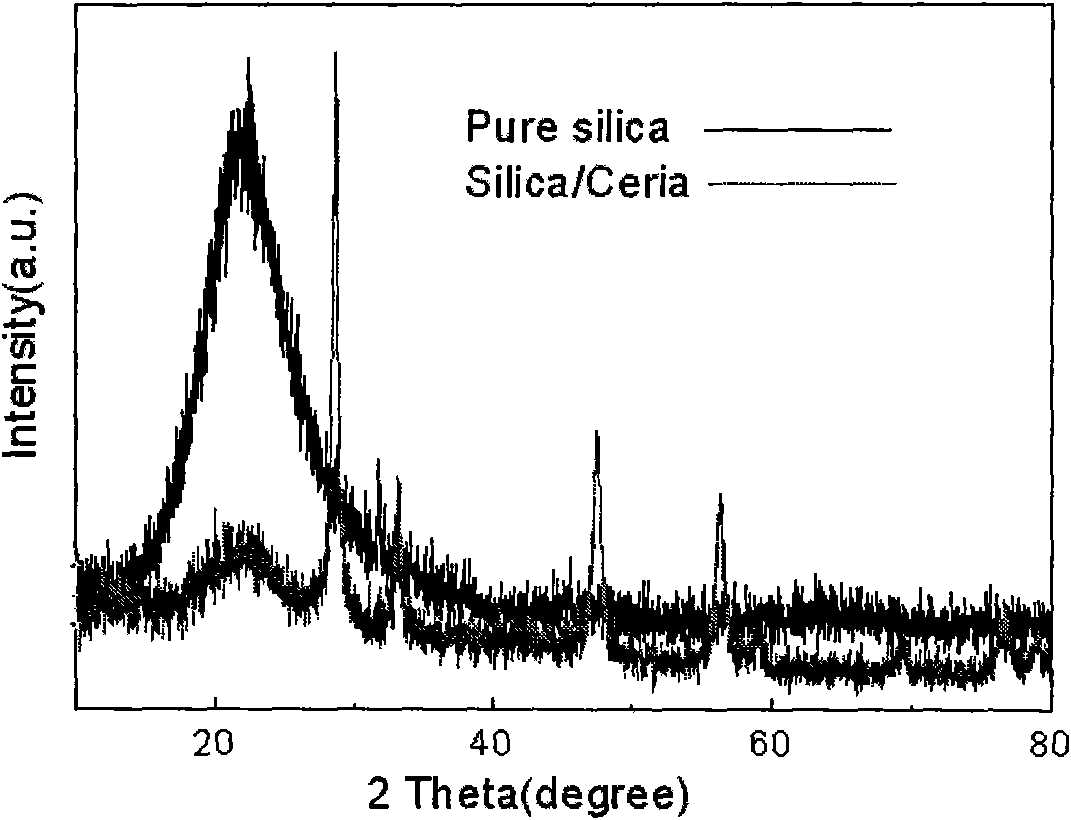Method for preparing silica/ceria composite abrasive grains
A technology of composite abrasive grains and silicon oxide, applied in chemical instruments and methods, semiconductor/solid-state device manufacturing, manufacturing tools, etc., can solve problems such as difficult post-cleaning, scratches, etc., to improve polishing removal rate and selectivity ratio, eliminate Scratch, roughness reduction effect
- Summary
- Abstract
- Description
- Claims
- Application Information
AI Technical Summary
Problems solved by technology
Method used
Image
Examples
Embodiment 1
[0026] Prepare 40ml of silica sol with a weight concentration of 2%, the average particle size of the silica particles is 80nm, add 0.5g of polyvinylpyrrolidone, stir to dissolve, then add 5mmol of cerous nitrate hydrate, stir to dissolve, and transfer the dispersion Put it in a 60ml stainless steel autoclave with a Teflon liner, seal it, place it in an oven, heat it to 140°C, and react for 12 hours. After the reaction is completed, ultrafiltration, dilution, and ultrafiltration are repeated five times in this way, followed by drying to finally obtain silicon oxide / cerium oxide composite abrasive grains. The X-ray diffraction pattern and transmission electron microscope photograph of the prepared silicon oxide / cerium oxide core-shell composite abrasive are as follows: figure 1 with figure 2 shown. It can be seen from the figure that the product abrasives are all silicon oxide / cerium oxide composite abrasives with a core-shell structure, without homogeneous nucleated cerium ...
Embodiment 2
[0028] Prepare 40ml of silica sol with a weight concentration of 2%, the average particle size of the silica particles is 80nm, add 0.5g of polyvinylpyrrolidone, stir to dissolve, then add 5mmol of cerous nitrate hydrate, stir to dissolve, and transfer the dispersion Put it into a 60ml stainless steel autoclave with a Teflon lining, seal it, place it in an oven, heat it to 160°C, and react for 12 hours. After the reaction is completed, ultrafiltration, dilution, and ultrafiltration are repeated five times in this way, followed by drying to finally obtain silicon oxide / cerium oxide composite abrasive grains. The transmission electron microscope observation shows that the product abrasives are all silicon oxide / cerium oxide composite abrasives with a core-shell structure, and there is no homogeneous nucleated cerium oxide particles.
Embodiment 3
[0030] Prepare 40ml of silica sol with a weight concentration of 5%, the average particle size of silicon oxide is 80nm, add 1g of polyvinylpyrrolidone, magnetically stir to dissolve, then add 10mmol of cerium acetate, stir to dissolve, transfer this dispersion to a volume of 60ml In a stainless steel high-pressure reaction kettle with a polytetrafluoroethylene lining, after sealing, place it in an oven, heat it to 120°C, and react for 24 hours. After the reaction was completed, it was centrifuged, purified and dried as in Example 1 to finally obtain silicon oxide / cerium oxide composite abrasive grains. The transmission electron microscope observation shows that the product abrasives are all silicon oxide / cerium oxide composite abrasives with a core-shell structure, and there is no homogeneous nucleated cerium oxide particles.
PUM
| Property | Measurement | Unit |
|---|---|---|
| particle diameter | aaaaa | aaaaa |
Abstract
Description
Claims
Application Information
 Login to View More
Login to View More - R&D
- Intellectual Property
- Life Sciences
- Materials
- Tech Scout
- Unparalleled Data Quality
- Higher Quality Content
- 60% Fewer Hallucinations
Browse by: Latest US Patents, China's latest patents, Technical Efficacy Thesaurus, Application Domain, Technology Topic, Popular Technical Reports.
© 2025 PatSnap. All rights reserved.Legal|Privacy policy|Modern Slavery Act Transparency Statement|Sitemap|About US| Contact US: help@patsnap.com



